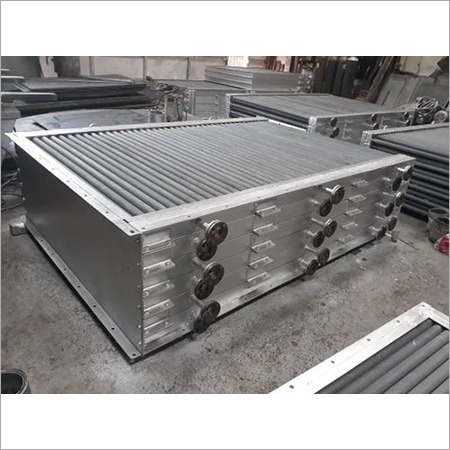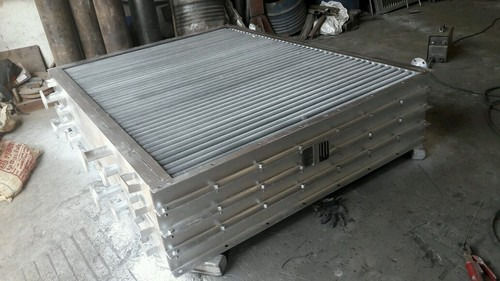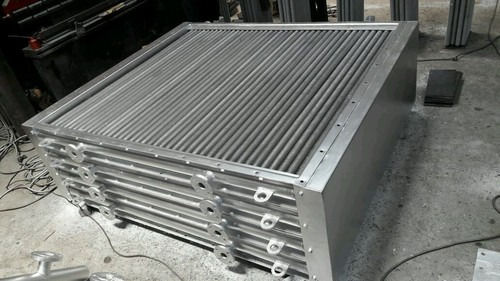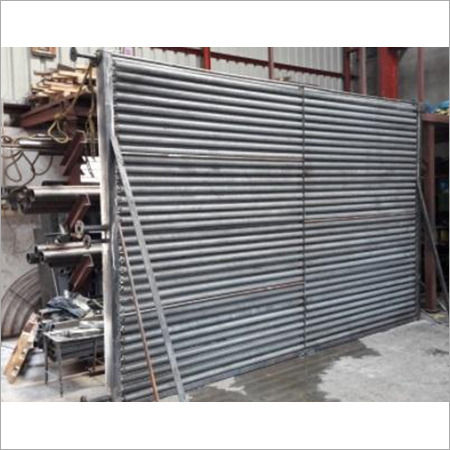
Steam Heat Exchanger
25000 INR/Unit
Product Details:
- Product Type Heat Exchanger
- Color silver
- Size Different Sizes Available
- Usage Industrial
- Condition New
- Structure tube Heat Exchanger
- Click to view more
X
Steam Heat Exchanger Price And Quantity
- 1 Unit
- 25000 INR/Unit
Steam Heat Exchanger Product Specifications
- silver
- New
- tube Heat Exchanger
- Heat Exchanger
- Different Sizes Available
- Industrial
Steam Heat Exchanger Trade Information
- 1 Unit Per Week
- 1 Days
Product Description
Steam Heat Exchanger is a multi-tubular heat transfer unit that rejects the heat gain by the working fluid to condense back into the liquid forms. It is provided with two flanged ports to make rigid and leakproof connections with inlet and discharge pipes. The high heat exchange of this industrial unit makes it highly demanding and popular among our customers. This product offered by us can be used in various high-pressure and temperature HVAC systems.
Uses of Steam Heat Exchanger:
Steam heat exchangers play a crucial role in various industrial processes and applications. These devices transfer heat from steam to another fluid or substance, facilitating processes such as heating, cooling, and condensation. Here are some common uses of steam heat exchangers:
1. Industrial Heating: Steam heat exchangers are widely used for heating in industrial applications. They can be employed to raise the temperature of air, water, or other fluids in processes such as drying, sterilization, and chemical reactions.
2. Power Generation: In power plants, steam is often used to generate electricity. Steam heat exchangers play a key role in this process by transferring heat from the steam to a working fluid (such as water) to produce steam for driving turbines.
3. HVAC Systems: Steam heat exchangers are utilized in heating, ventilation, and air conditioning (HVAC) systems for both residential and commercial buildings. They help in heating air or water that is circulated to provide warmth in buildings.
4. Process Industries: Various industries, including chemical, petrochemical, and pharmaceutical, use steam heat exchangers in their processes. These devices assist in maintaining specific temperatures required for reactions, distillation, and other manufacturing processes.
5. Food and Beverage Processing: Steam heat exchangers are employed in the food and beverage industry for processes such as pasteurization, sterilization, and cooking. They help in maintaining precise temperatures to ensure product quality and safety.
6. Oil Refining: In the oil refining industry, steam is often used for heating and various thermal processes. Steam heat exchangers help in transferring heat efficiently in processes like crude oil distillation.
7. Waste Heat Recovery: Steam heat exchangers can be used to recover and utilize waste heat from industrial processes. This helps improve overall energy efficiency and reduces energy consumption.
8. District Heating Systems: In some urban areas, district heating systems use steam heat exchangers to distribute heat generated centrally to multiple buildings. This can be more efficient than individual heating systems for each building.
9. Brewing and Distilling: In the brewing and distilling industries, steam heat exchangers are used for heating and cooling during the fermentation and distillation processes.
10. Textile Industry: Steam heat exchangers are utilized in the textile industry for processes such as dyeing and drying, where precise temperature control is essential for quality and efficiency.
11. Paper and Pulp Industry: In the production of paper and pulp, steam heat exchangers are employed for various heating and drying applications.
Steam Heat Exchanger FAQ:
Q. What is a steam heat exchanger?
Ans: A steam heat exchanger is a device designed to transfer heat between steam and another fluid. It facilitates the exchange of thermal energy for various industrial processes.
Q. How does a steam heat exchanger work?
Ans: Steam heat exchangers work by allowing steam to come into contact with another fluid (such as water or air). Heat is transferred from the steam to the other fluid, raising its temperature or causing a phase change.
Q. What are the types of steam heat exchangers?
Ans: There are various types, including shell and tube heat exchangers, plate heat exchangers, and finned-tube heat exchangers. The choice depends on factors like the application, available space, and efficiency requirements.
Q. Where are steam heat exchangers used?
Ans: Steam heat exchangers are used in a wide range of industries, including power generation, chemical processing, HVAC systems, food and beverage, oil refining, and many others.
Q. What is the purpose of a steam heat exchanger in a power plant?
Ans: In a power plant, a steam heat exchanger is often used to transfer heat from steam to water. This heated water then produces steam to drive turbines for electricity generation.
Q. How are steam heat exchangers cleaned and maintained?
Ans: Maintenance typically involves regular inspection for any signs of corrosion or scaling. Cleaning methods may include chemical cleaning, mechanical cleaning, or other methods depending on the type of fouling.
Q. What considerations are important when selecting a steam heat exchanger?
Ans: Factors to consider include the type of fluid being heated or cooled, the required temperature range, pressure conditions, space constraints, and the efficiency of the heat exchanger.
Q. How can steam heat exchangers contribute to energy efficiency?
Ans: Steam heat exchangers can contribute to energy efficiency by recovering waste heat, improving overall system efficiency, and optimizing temperature control in industrial processes.
Q. Can steam heat exchangers be used for both heating and cooling?
Ans: Yes, steam heat exchangers can be designed for both heating and cooling applications. The direction of fluid flow and the temperature of the fluids determine whether the heat exchanger functions as a heater or a cooler.
Q. What is the role of steam heat exchangers in district heating systems?
Ans: In district heating systems, steam heat exchangers help distribute heat generated centrally to multiple buildings, providing an efficient and centralized heating solution for urban areas.
Q. Are there safety considerations when working with steam heat exchangers?
Ans: Yes, safety is crucial. Proper installation, maintenance, and adherence to safety guidelines are essential. Steam is at high temperatures and pressures, so precautions must be taken to prevent accidents.
Tell us about your requirement

Price:
Quantity
Select Unit
- 50
- 100
- 200
- 250
- 500
- 1000+
Additional detail
Mobile number
Email
Other Products in 'Heat Exchanger' category
 |
THERMAL ENERGY SOLUTIONS
All Rights Reserved.(Terms of Use) Developed and Managed by Infocom Network Private Limited. |






